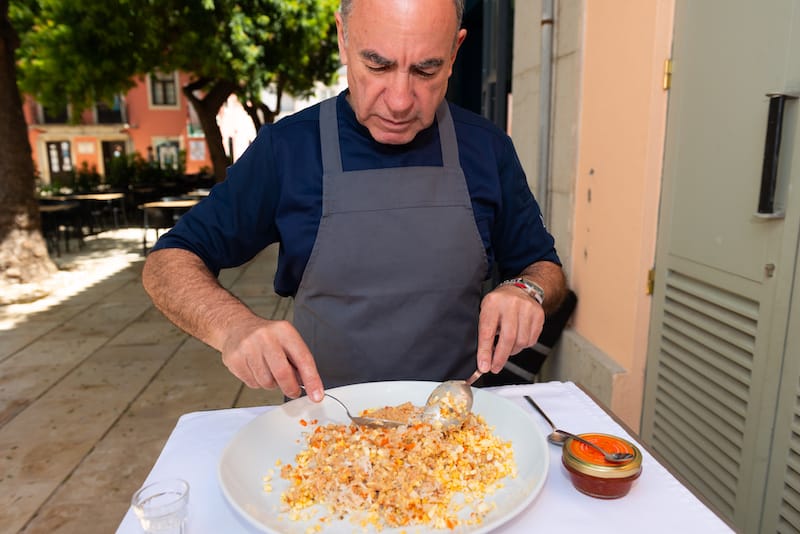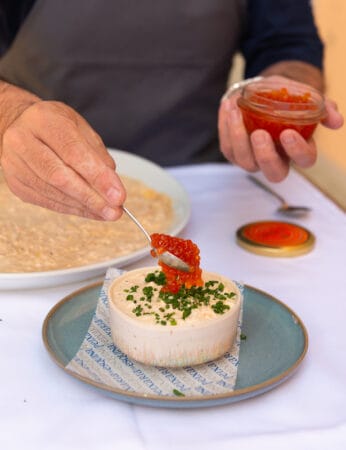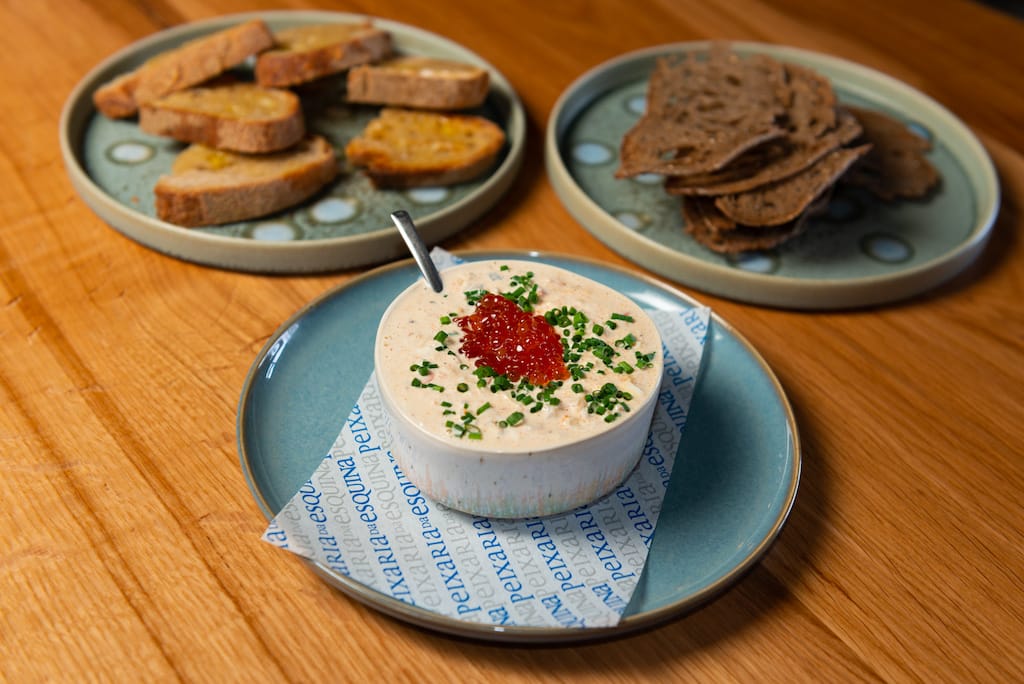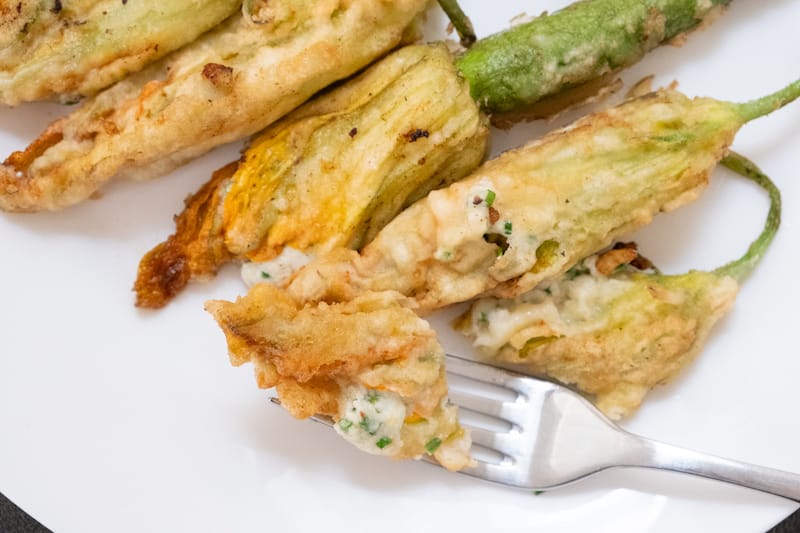We are in Lota da Esquina, in Cascais, staring down a small bowl filled to the brim with a mix of crab meat, chopped eggs, mayonnaise and other seasonings. On the surface, it looks like a straightforwardly decadent dish but according to chef/owner Vítor Sobral, it’s actually a way to boost a product that’s not quite at its peak.

“During the summer months, crabs are skinny; they don’t have much fat,” explains Vítor. “This dish is a way of adding fatty ingredients.”
The dish we’re discussing is sapateira recheada, Portugal’s “stuffed” crab, a staple at seafood restaurants and family celebrations alike.
“It’s a dish for sharing,” explains the chef when we ask what role the dish plays in Portugal. “It’s served at restaurants and is made at home, especially for special occasions, such as watching a football game.”
As with most dishes associated with special occasions, it’s not cheap – crabs cost as much as 20 euros per kilo even in seafood-rich Portugal. But Vítor tells us that this wasn’t always the case. “Sixty years ago, [crab] was the food of poor people. Fishermen used to trade crabs for lard.”

These days, the dish is typically made with sapateira, known in English as brown crab, which has large claws that pack lots of meat. But Vítor tells us that the dish can also be made with santola, spider crabs, which have less but sweeter flesh, making it even more luxe (and expensive).
Vítor’s take on sapateira recheada revolves around the traditional essentials – crab meat, mayonnaise, pickles and hard-boiled eggs. But he gives the dish a subtle, aromatic boost with the addition of a splash of gin, and he garnishes his version with chopped chives – ostensibly for color – and salmon roe – ostensibly for yet another hit of decadence.

The end result is undeniably rich from all those fatty ingredients but with the flavor of crab still shining through, and according to the chef, boasting a bite of salt “To remind one of the ocean.”
Sapateira recheada is essentially a dip, and as served at seafood restaurants and beerhalls in Portugal, it’s often paired with thick slices of toasted, buttered bread. But Vítor prefers to serve it with thin, plain toasts, as “The flavor is already rich.”

Recipe: Sapateira recheada, Portuguese-style stuffed crab
This recipe represents Portuguese chef Vítor Sobral’s take on an otherwise traditional dish via additions of gin and two non-standard, and optional, garnishes.
Portuguese pickles, which provide the dish with a subtle hit of acidity and a pleasant crunch, generally include a mix of cauliflower, carrot and cucumber.
At Lota da Esquina, sapateira recheada is made with house-made mayonnaise that includes a bit of mustard; here we suggest using store-bought mayonnaise and supplementing it with classic yellow mustard.
The chef serves the dish in a small bowl, but traditionally it’s served in a crab shell.
Serves 4
1 whole, live brown crab or one frozen, pre-boiled crab (approximately 1 kg total)
1 hard-boiled egg, shelled and chopped finely
4 tablespoons chopped mixed pickles
2 tablespoons mayonnaise
1 tablespoon gin (optional)
2 teaspoons yellow mustard
¼ teaspoon salt
1 or 2 grinds of black pepper
1 teaspoon chopped chives (optional)
1 teaspoon salmon eggs (optional)
Thinly-sliced, toasted bread

If using live crab, kill the crab humanely. Bring several liters of salted water to a rolling boil. Add the crab, boil for 15 minutes. Remove from water. When cool enough to handle, crack the legs and claws and remove the meat. Open the body and remove the interior. Remove and discard the lungs. Remove and reserve the meat surrounding the inner cartilage. Scrape the fatty bits from the body and shell, chop and retain. A 1kg brown crab should yield around 400g of crab meat and fatty bits. Clean and retain the body shell.
Add the crab flesh, fatty bits, egg and pickles to a medium mixing bowl. Stir to combine. Add mayonnaise, gin (if using), mustard, salt and black pepper. Stir to combine. Taste, adjusting seasonings if necessary; the dish should taste rich from the mayonnaise but with the flavor of crab still present, and should taste slightly salty with an occasional and pleasant crunch from the pickles.
Scoop the mixture back into the reserved shell (or to a bowl), garnish with the chives and salmon eggs (if using). Serve at room temperature or chilled with toasted bread.
 July 17, 2024 Recipe
July 17, 2024 Recipe
Back in the day, according to legend, a man named Köpoğlu spent all his money on rakı, […] Posted in Istanbul July 4, 2024 Recipe
July 4, 2024 Recipe
Summer markets in Marseille come alive, bathed in a colorful, brilliant bounty when […] Posted in Marseille June 25, 2024 Recipe
June 25, 2024 Recipe
We’re in Os Papagaios, the restaurant Joaquim Saragga oversees in Lisbon’s Arroios […] Posted in Lisbon
Austin BushAustin Bush
Published on June 28, 2023
Related stories
July 17, 2024
Istanbul | By Lian Penso Benbasat
IstanbulBack in the day, according to legend, a man named Köpoğlu spent all his money on rakı, the Turkish spirit made from grapes and anise, and was left with no money to buy food. Hungry, pockets empty, he went home and grabbed a couple of eggplants, some tomatoes and garlic from his garden and threw…
July 4, 2024
MarseilleSummer markets in Marseille come alive, bathed in a colorful, brilliant bounty when fruits and vegetables are in their prime. There are over 25 open markets in Marseille and, every Saturday, our mornings are booked. We set out to one of our neighborhood favorites, the market at Place Sébastopol in the town center, to search…
June 25, 2024
LisbonWe’re in Os Papagaios, the restaurant Joaquim Saragga oversees in Lisbon’s Arroios neighborhood, where we’ve asked him to show us how to make one of Lisbon’s more iconic dishes: ervilhas guisadas, peas braised with Portuguese sausages, typically crowned with poached eggs. Come spring, Portugal revels in green-hued produce: fava beans, asparagus, artichoke, spinach and other…






















































































